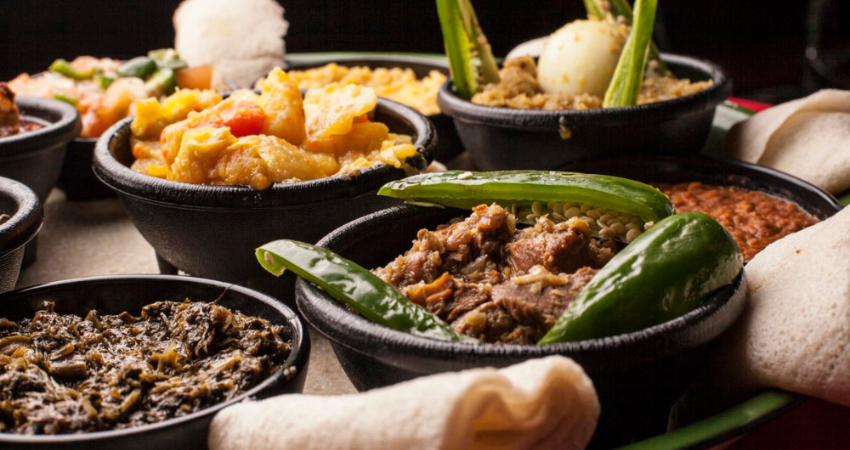
Ethiopia stands apart from the rest of Africa with its distinctive and remarkably rich cultural heritage. This uniqueness extends to its Ethiopian food, which offers a delightful array of flavors and traditions waiting to be explored. While Ethiopian food is gradually gaining more global recognition, it remains somewhat of a hidden gem, shrouded in mystery for many.
Eating the Famous Ethiopian Food way requires rethinking some conventional assumptions about dining. Say goodbye to cutlery and embrace the communal experience of getting your fingers delightfully messy. The foundation of the best Ethiopian Food is injera, a large, spongy, grayish flatbread that serves as both a plate and utensil. On its strangely rubbery surface, an enticing spread of vibrant mounds is arranged – from spicy stews to vegetable curries and even cubes of raw meat. This mode of eating encourages an intimate shared experience, with everyone gathered around a large circular metal tray laden with injera and a diverse array of dishes, as hands move back and forth, tearing off strips of injera to scoop up the flavorful morsels.
Like their Indian counterparts, Ethiopians are not shy about adding spices to their dishes. One of the most common accompaniments is berbere, a complex spice blend containing up to 16 ingredients, including chile powder, fenugreek, ginger, garlic, cardamom, and cinnamon. This vibrant mixture infuses many Ethiopian dishes with a distinctive warmth and depth of flavor.
No Ethiopian meal would be complete without sampling the country’s renowned Ethiopian Coffee. Ethiopia is widely regarded as the birthplace of quality Arabica coffee, and its beans are praised as some of the finest in the world. Savoring a cup of Ethiopian coffee after a flavorful meal is an absolute must, providing the perfect concluding note to a culinary journey.
Best Ethiopian Food that You Can Try
To truly immerse yourself in the rich tapestry of Ethiopian Cuisine. Here are the 15 best Ethiopian Dishes that you simply must try:
Tibs
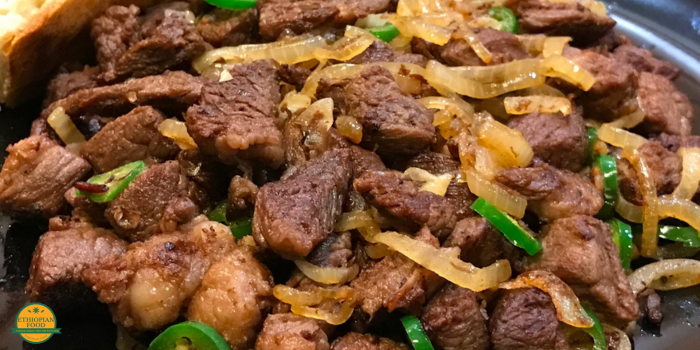
Sliced beef or lamb, pan-fried in butter, garlic, and onions. Tibs is one of the most popular dishes in Ethiopian Food. It comes in various forms, varying in the type, size, or shape of the meat cuts used, and can range from fiery hot to mildly spiced, with or without vegetables. One particularly recommended variation is shekla tibs, where strips of meat arrive at your table sizzling atop a clay pot stoked with hot coals – a dramatic and delicious presentation.
Historically, Ethiopian Tibs served as a sign of respect or to pay a compliment to someone. Today, it’s still viewed as a special dish, hence its popularity for commemorating events and holidays. Yet, it’s also a beloved casual fare – walk into a lively bar on a Friday afternoon. And you’ll likely find revelers enthusiastically ordering and devouring tibs.
The Beef Tibs are often cleaved from carcasses hanging outside the restaurant’s entrance, ensuring a level of freshness and flavor that can’t be beaten. Don’t be put off by the sight; this is as close to farm-to-table as it gets.
Kitfo
Kitfo Ethiopian Food recipes made from the leanest cuts of meat, kitfo is considered a true delicacy among ordinary Ethiopians revered for both its luxurious taste and nutritional value. Similar to French steak tartare, the meat is minced and warmed in a pan with a little butter, mitmita (a more potent version of berbere), and sometimes thyme. Kitfo is typically served leb leb (warmed but not cooked), although you can request it betam leb leb (“very warmed,” essentially cooked) if you prefer.
Kitfo is often accompanied by aib (a dry cottage cheese-like cheese) and gomen (minced spinach), a combination that enhances the dish’s flavor and makes for an incredibly satisfying and filling meal – ideal after a long day of travel or to cure a hangover from the night before.
Beyainatu

“A bit of every type,” Beyainatu” is one of the most popular vegetarian Ethiopian Dishes. And it lives up to its name. Your injera arrives blanketed in colorful piles of tasty vegetables, potatoes, curries, lentil stews, and more, creating a veritable riot of flavors and textures.
Due to Ethiopia’s strong tradition of religious fasting and abstaining from meat on Wednesdays and Fridays, beyainatu is widely available throughout the country, served everywhere from fancy hotels to humble roadside food shacks. When faced with an Amharic-only menu or unsure of what to order, beyainatu is a safe and satisfying choice.
Many visitors to Ethiopia, regardless of their dietary preferences, return proclaiming beyainatu as their favorite meal – a testament to the dish’s irresistible appeal.
Fuul
Popular across East Africa and the Middle East, Ethiopian fuul is a hearty mix of stewed and spiced fava beans, enjoyed by many Ethiopians as a breakfast staple.
Regular fuul is typically served as a modest yet filling portion, accompanied by an endless supply of fresh bread. For a more substantial experience, order “special fuul,” which is large enough to share and comes with yogurt, tomato, green chile, onion, egg, and occasionally avocado. Locals enjoy mashing everything together and seasoning it further with salt, additional spices, and fresh chiles.
You know you’re in the right fuul-serving establishment when it’s brought to you in small metal bowls too hot to touch, prompting you to tear off a piece of bread to grip the sides.
In the bustling city of Addis Ababa, fuul serves as a healthy and quick breakfast option, often cooked and dispensed from vast pots, allowing customers to be well-fed within ten minutes before heading off to start their day.
Tere Siga

Not for the faint-hearted, one of Ethiopia’s most popular delicacies is tere siga – cubes of raw red meat. Typically, two people order half a kilo to share, which is eaten with injera or bread, using the flatbread to clasp and dip the carved meat into copious amounts of mitmita.
One legend suggests that Ethiopians developed a love for raw meat as a military tactic during the 16th century, allowing fighters to avoid detection by not having to start cooking fires.
While most Ethiopians seem to suffer no ill effects from eating tere siga – many even claim it makes them feel invigorated – consuming raw meat does carry some health risks, such as tapeworm or salmonella. However, with proper precautions (a simple tablet available at pharmacies can neutralize any tapeworm risk), indulging in this unique delicacy can be an unforgettable experience.
Doro Wot
Doro Wot, Ethiopia’s version of curry, is the best companion of injera. While beef and goat are common protein choices.
This dish features chicken drumsticks or wings cooked and served in a fiery sauce made from butter, onions, chiles, cardamom, and berbere. Incongruously bobbing amidst the stew is a hard-boiled egg, which serves as a delicious accompaniment and is often offered to guests as a sign of respect.
For Ethiopians, Doro wot is the celebratory meal of choice during national and religious festivals, with women often seen carrying upside-down clucking chickens by their feet the day before in preparation.
Enkulal Firfir
While it may sound unassuming, Enkulal Firfir – essentially scrambled eggs – is a breakfast dish not to be missed in Ethiopia. Cooked with nitre kibe (Ethiopian spiced butter) and enhanced with a combination of green and red peppers, chiles, tomatoes, and onions, these scrambled eggs are scooped up with fresh, warm bread rolls, often straight from the bakery.
The best part of Enkulal Firfir is its fantastically vibrant yellow hue, which translates into a superior taste compared to the results of pallid egg yolks common in the West. The omelet version is known as Enkulal tibs.
Dulet
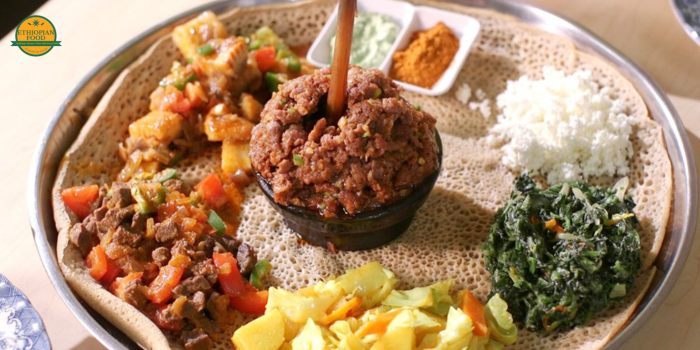
For the uninitiated, this dish of mixed meats might be more enjoyable if not translated and explained beforehand. Dulet is made with Boneless(an animal’s stomach lining), along with liver and lean beef, all fried in butter, onions, chiles, cardamom, and pepper.
Like Kitfo, much of dulet’s popularity stems from its hearty and immensely satisfying nature, perfect for replenishing energy after a long day or a lively night out. Offal has never tasted so delectable – give it a try and be pleasantly surprised.
Ti’hilo
A specialty hailing from Tigray, Ethiopia’s northernmost region, Ti’hilo is the country’s answer to Swiss fondue. It consists of barley balls pierced by carved sticks with two prongs at the end, which are then dipped into a fiery-looking sauce made from pulses, flour, and spices.
As with much of Ethiopian dining, there’s a touch of ceremony surrounding this Famous Ethiopian Food. A person will come to your table and sit beside you, scooping from a triangular wedge of barley and rolling it between their hands into little balls, which are then placed on the injera tray for you to spear, dip, and savor.
Long associated with a small part of Tigray, particularly around the city of Adigrat, the tasty and nutritious benefits of ti’hilo have led to its growing popularity throughout Ethiopia.
Dabbo Firfir
Comprising torn-up bits of unleavened bread mixed with clarified butter and berbere, and often accompanied by yogurt, Dabbo firfir is a prime example of Ethiopian cooking’s ability to transform simple ingredients into something extraordinary.
Like shiro, dabbo firfir may not look particularly impressive at first glance, but its flavor is surprisingly delightful. As a rare exception, Ethiopians are willing to resort to using a spoon or fork for this dish.
Fatira
A beloved breakfast dish in Africa. Fatira typically consists of a thin pastry top and bottom with scrambled eggs and honey wedged in between. Typically served in generous portions, this perfect combination of savory and sweet can easily satisfy two people.
Fatira also comes in a street food version, with small square pieces cooked in the open on a giant frying pan, particularly popular in the beguiling eastern city of Harar.
Accompanied by a freshly brewed cup of Ethiopian Coffee, there are few better ways to start a day of exploring Ethiopia’s wonders.
Asa
Eating fish Asa is the best experience that you can have with Famous Ethiopian Food. Typically, a fish like Nile perch is fried and served entirely whole, with its gaping mouth of jagged little teeth resembling a piranha on your plate.
As with most Ethiopian dishes, asa is eaten by hand, using either bread or injera to scoop up the fish, accompanied by a fiery sauce for dipping. Ethiopians leave little to waste, savoring every morsel, including the surprisingly tasty grilled fins.
If you prefer to avoid picking out bones or confronting the fish’s angry-looking face, opt for asa tibs – chunks of fish marinated in berbere spice and lime juice, then fried in sesame oil, olive oil, paprika, grated garlic, and ginger.
Shiro
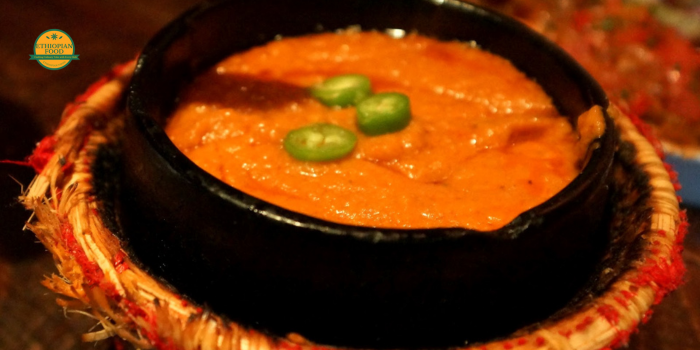
A lightly spiced chickpea or bean purée, shiro is a particular favorite among Ethiopians on fasting days. Unassuming in appearance, it may seem like nothing more than a simple slop, but don’t be deceived – shiro is remarkably tasty.
Shiro is often prepared with the addition of minced onions, garlic, and, depending on regional variations, ground ginger or chopped tomatoes and chile peppers, further boosting its flavor profile.
Tegabino shiro is a variation where heavily spiced legumes, flour, oil or butter, and water are brought to a boil and then served bubbling in a miniature clay pot right at the table – a delightful spectacle.
Spriss
Spriss is moreover a house of juice often little more than a shake – serving Spriss. Delicious juice blends made from fruits like avocado, guava, papaya, mango, pineapple, and orange.
Spriss is created by pouring layers of pure, unsweetened puréed fruit juices on top of each other, topped with a squeeze of lime. Some Ethiopians add a dash of a mysterious purple cordial, lending a satisfyingly sweet touch.
A glass of spriss is often accompanied by a triangular wedge of sweetened bread, making for a refreshing and filling snack – especially if you opt for a glass filled solely with velvety avocado purée. Spriss offers a sweet respite from the spicier flavors of Famous Ethiopian cuisine.
Pasta Beu Injera
Italy’s historical involvement in Ethiopia means that if you need a break from the ever-present injera – or if your stomach is feeling delicate and you need something gentle – help is at hand in the form of Pasta Beu atkilt, pasta with vegetables, readily available throughout the country.
Ordering pasta Beu Siga pasta with meat will get you something akin to a tasty spaghetti Bolognese. Alternatively, if you haven’t been overwhelmed by injera and crave a quirky fusion, try pasta beu injera: a heap of pasta incongruously lumped atop a serving of injera.
Ethiopians stay true to tradition. A fork is only used to cut the pasta into manageable bites, after which it is all scooped up with injera clasped between the fingers, as is customary. It’s a particularly tricky endeavor for first-timers but results in one of the most filling meals you can find – a true carb-lover’s dream.
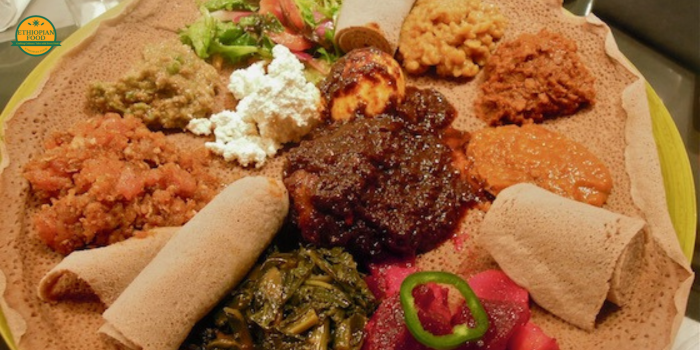
Experiencing Ethiopian food directly opens up one’s palate and expands the Culinary horizons. It is a dynamic and diverse world. Every meal provides a window into Ethiopia’s fascinating culture and customs. From the social act of sharing platters heaped with injera to the precise mixing of spices and the distinct tastes of dishes like kitfo and tere siga. Accept the journey, relish the tastes, and let this exceptional food make a lasting impression on your taste buds and perception of one of Africa’s finest countries.
What is Ethiopian Food?
Ethiopian food is a cuisine that features spicy vegetable and meat dishes, often made with a berbere spice blend. Popular dishes include injera (a spongy flatbread), doro wat (chicken stew), and shiro (chickpea stew).
How to eat Ethiopian Food?
To eat Ethiopian food, you use the spongy injera bread to scoop up stews and vegetable dishes with your hands. Sharing food from a communal plate placed on a mesob (basket table) is traditional.
What is Wot Ethiopian Food?
Wot is a stew-like dish in Ethiopian cuisine that typically consists of meat, vegetables, or lentils simmered in a spiced sauce or curry. Ex:-Doro wot and siga wot.
What is Gomen Ethiopian Food?
Gomen is a popular Ethiopian vegetable dish made with collard greens or similar leafy greens. It is cooked with spices, garlic, and other ingredients like ginger and onions.
What is Tibs in Ethiopian food?
Tibs is an Ethiopian dish consisting of sautéed meat (usually beef or lamb) that is pan-fried with onions, butter, and spices. It is often served alongside injera bread and other vegetable dishes.